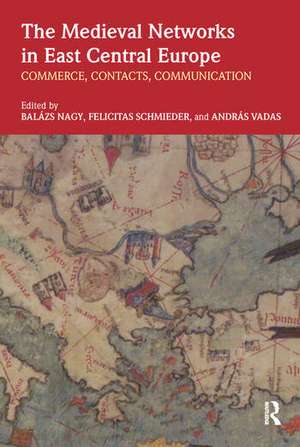The Medieval Networks in East Central Europe: Commerce, Contacts, Communication
Editat de Balazs Nagy, András Vadas, Felicitas Schmiederen Limba Engleză Paperback – noi 2018
Medieval Networks in East Central Europe explores the economic, cultural, and religious forms of contact between East Central Europe and the surrounding world in the eight to the fifteenth century. The sixteen chapters are grouped into four thematic parts: the first deals with the problem of the region as a zone between major power centers; the second provides case studies on the economic and cultural implications of religious ties; the third addresses the problem of trade during the state formation process in the region, and the final part looks at the inter- and intraregional trade in the Late Middle Ages.
Supported by an extensive range of images, tables, and maps, Medieval Networks in East Central Europe demonstrates and explores the huge significance and international influence that East Central Europe held during the medieval period and is essential reading for scholars and students wishing to understand the integral role that this region played within the processes of the Global Middle Ages.
| Toate formatele și edițiile | Preț | Express |
|---|---|---|
| Paperback (1) | 370.10 lei 43-57 zile | |
| Taylor & Francis – noi 2018 | 370.10 lei 43-57 zile | |
| Hardback (1) | 1013.72 lei 43-57 zile | |
| Taylor & Francis – 30 oct 2018 | 1013.72 lei 43-57 zile |
Preț: 370.10 lei
Nou
70.84€ • 76.97$ • 59.54£
Carte tipărită la comandă
Livrare economică 21 aprilie-05 mai
Specificații
ISBN-10: 1138554855
Pagini: 316
Ilustrații: 16 Tables, black and white; 32 Halftones, black and white
Dimensiuni: 156 x 234 x 22 mm
Greutate: 0.46 kg
Ediția:1
Editura: Taylor & Francis
Colecția Routledge
Locul publicării:Oxford, United Kingdom
Public țintă
Postgraduate and UndergraduateCuprins
Notă biografică
Felicitas Schmieder is Professor of Pre-Modern History at Fernuniversität Hagen. Her main research interests are the history of cross-cultural contacts, urban history, cultural memory, and pre-modern cartography.
András Vadas is Assistant Professor of Medieval History at Eötvös Loránd University, Budapest. His research interests are the environmental, urban, and economic history of the Middle Ages and the Early Modern period.
Recenzii
Aleks Pluskowski, University of Reading, UK
'This book presents important research by leading and emerging scholars on an often neglected region of Europe. The essays in The Medieval Networks in East Central Europe cover a wide variety of topics with a particular emphasis on trade relations, both within the region and with Western Europe and Asia, which will appeal to medievalists in general, not just specialists in this region. In fact, the essays in this book demonstrate that the medieval history of this region is an essential part not only of European history but also of Europe’s place in world history.'
Paul Milliman, University of Arizona, USA
Descriere
Medieval Networks in East Central Europe explores the economic, cultural, and religious forms of contact between East Central Europe and the surrounding world in the eight to the fifteenth century. The sixteen chapters are grouped into four thematic parts: the first deals with the problem of the region as a zone between major power centers; the second provides case studies on the economic and cultural implications of religious ties; the third addresses the problem of trade during the state formation process in the region, and the final part looks at the inter- and intraregional trade in the Late Middle Ages.
Supported by an extensive range of images, tables, and maps, Medieval Networks in East Central Europe demonstrates and explores the huge significance and international influence that East Central Europe held during the medieval period and is essential reading for scholars and students wishing to understand the integral role that this region played within the processes of the Global Middle Ages.


